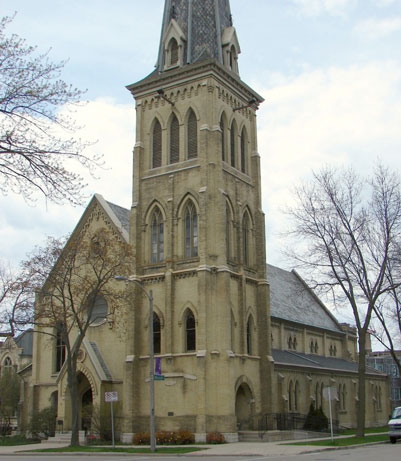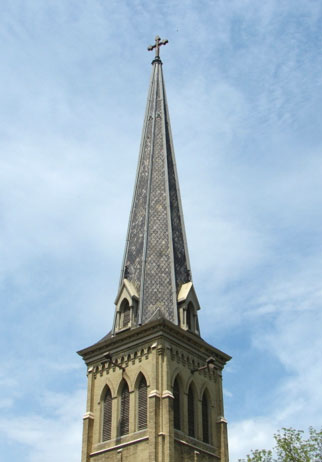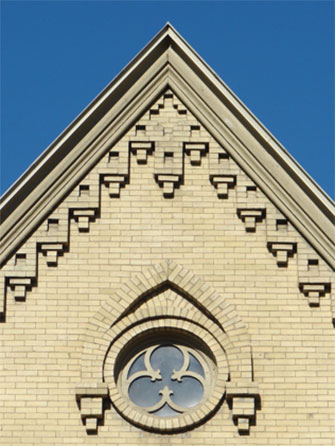26. Olivet Congregational, 1868
Now All Saints Episcopal Cathedral
818 East Juneau Avenue (at Marshall Street)
Architect: Edward Townsend Mix
Plymouth Congregational Church, the city’s first church of this denomination, founded the Astor Street Mission in the Yankee Hill neighborhood in 1858. Three years later, the mission became Olivet Congregational Church. Construction of the church on Juneau Avenue began in the summer of 1868 and was completed in November of 1869. However, the building served the Congregational Church for only a few years. Dissention within the congregation led many members to leave for Plymouth Congregational or the nearby Immanuel Presbyterian Church. The congregation of Olivet, much diminished in size, sold the church in 1873 and disbanded a few years later. The Episcopal Diocese of Wisconsin acquired the building for $35,000, just a bit more than half of the original cost to acquire the land and construct the church.
At the time of the acquisition, the Episcopal diocese had a small wooden chapel on a lot adjacent to Olivet Congregational, along with a rectory and bishop’s residence. By acquiring the recently completed Congregational church, the Episcopal diocese was able to replace its small chapel with a much larger place of worship without relocating. From the time of its acquisition, the building was intended to serve as the cathedral for the Episcopal Diocese of Wisconsin rather than as a parish church.
As the seat of the Episcopal bishop and the administrative center for the diocese, All Saints does not encroach on the territory of St. Paul’s, an Episcopal parish church built just one block to the north of All Saints in 1883. This is a rare instance in Milwaukee in which two churches of the same denomination are located just one block apart, although historically there was a cluster of Lutheran churches in the Walker’s Point neighborhood, serving speakers of different languages. There are also currently a few pairs of Baptist churches very close to each other on the North Side.
The Episcopal diocese gradually replaced its earlier buildings on the property, constructing the present guild hall in 1891 and a new bishop’s residence in 1902. The guild hall extends from the northwest corner of the church and includes offices, a library, Sunday school and meeting rooms, and a kitchen. The church and the two later buildings are compatible in their scale, exterior materials, and architectural details, and are arranged to form three sides of a central courtyard facing Juneau Avenue.
Olivet Congregational has many similarities with the slightly earlier St. James Episcopal. Both churches have basilican plans with no transepts, with a single tower at one side of the front entrance. Also like St. James, the width of Olivet Congregational is such that it could have been spanned without interior columns. The full width of the nave and side aisles is less than the width of the older St. John’s Catholic Cathedral, which originally had no interior columns. The choice of a basilican plan rather than a more open interior without columns shows the allegiance of both the architects and their clients to a traditional type of church design.
As originally built, all of the windows at Olivet Congregational had leaded glass with diamond-shaped pieces. Only six of these remain: the two tall windows on the upper level of the façade and the four windows in the second stage of the tower. All of the others were replaced by the current pictorial windows after the Episcopal diocese acquired the church from the Congregationalists. There have been several other alterations to the church since its construction in the late 1860s, including an extension of the chancel in 1908. This extension is just the width of the nave, excluding the side aisles, and increased the length of the church by 14 feet. The exterior walls were cleaned in the 1980s, restoring the Cream City brick to its original color. The oldest of several historic churches in the Yankee Hill neighborhood, All Saints Cathedral is an excellent example of a Victorian era Gothic Revival church.
Sources:
“Dedication of Olivet Church,” Milwaukee Sentinel, November 26, 1869, page 1, column 2.
DeHaas, John N., Jr., and Mary Ellen Wietczykowski. All Saints Episcopal Cathedral. Historic American Buildings Survey, 1969. HABS No. WI-265.
Flower, Frank A. History of Milwaukee, Wisconsin. Chicago: Western Historical Company, 1881. Facsimile reprint by the Milwaukee Genealogical Society, 1981.
Flucke, Paul. Plymouth, a Church and its World; a History of Plymouth Church, Milwaukee, Wisconsin. Plymouth Church, 1984.
Johnston, James M. “All Saints Today Keeps 1869 Look,” Milwaukee Sentinel, February 25, 1978, part 1, page 9, column 1.
“Olivet Church,” Milwaukee Sentinel, November 16, 1869, page 1, column 3.
Szczesny-Adams, Christy. Cosmopolitan Design in the Upper Midwest: the Nineteenth Century Architecture of Edward Townsend Mix. Ph. D. dissertation, University of Virginia, 2007.
Wietczykowski, Mary Ellen. “Three Episcopal Churches in Milwaukee,” Historical Messenger, June 1970, pages 40-50.



